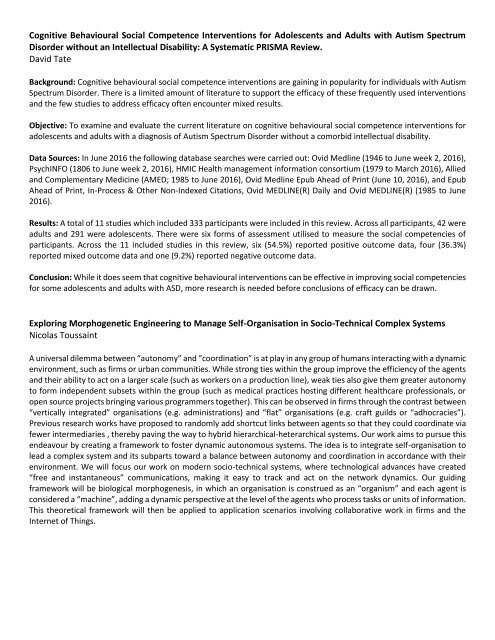Conference Programme FULL (1)
You also want an ePaper? Increase the reach of your titles
YUMPU automatically turns print PDFs into web optimized ePapers that Google loves.
Cognitive Behavioural Social Competence Interventions for Adolescents and Adults with Autism Spectrum<br />
Disorder without an Intellectual Disability: A Systematic PRISMA Review.<br />
David Tate<br />
Background: Cognitive behavioural social competence interventions are gaining in popularity for individuals with Autism<br />
Spectrum Disorder. There is a limited amount of literature to support the efficacy of these frequently used interventions<br />
and the few studies to address efficacy often encounter mixed results.<br />
Objective: To examine and evaluate the current literature on cognitive behavioural social competence interventions for<br />
adolescents and adults with a diagnosis of Autism Spectrum Disorder without a comorbid intellectual disability.<br />
Data Sources: In June 2016 the following database searches were carried out: Ovid Medline (1946 to June week 2, 2016),<br />
PsychINFO (1806 to June week 2, 2016), HMIC Health management information consortium (1979 to March 2016), Allied<br />
and Complementary Medicine (AMED; 1985 to June 2016), Ovid Medline Epub Ahead of Print (June 10, 2016), and Epub<br />
Ahead of Print, In-Process & Other Non-Indexed Citations, Ovid MEDLINE(R) Daily and Ovid MEDLINE(R) (1985 to June<br />
2016).<br />
Results: A total of 11 studies which included 333 participants were included in this review. Across all participants, 42 were<br />
adults and 291 were adolescents. There were six forms of assessment utilised to measure the social competencies of<br />
participants. Across the 11 included studies in this review, six (54.5%) reported positive outcome data, four (36.3%)<br />
reported mixed outcome data and one (9.2%) reported negative outcome data.<br />
Conclusion: While it does seem that cognitive behavioural interventions can be effective in improving social competencies<br />
for some adolescents and adults with ASD, more research is needed before conclusions of efficacy can be drawn.<br />
Exploring Morphogenetic Engineering to Manage Self-Organisation in Socio-Technical Complex Systems<br />
Nicolas Toussaint<br />
A universal dilemma between “autonomy” and “coordination” is at play in any group of humans interacting with a dynamic<br />
environment, such as firms or urban communities. While strong ties within the group improve the efficiency of the agents<br />
and their ability to act on a larger scale (such as workers on a production line), weak ties also give them greater autonomy<br />
to form independent subsets within the group (such as medical practices hosting different healthcare professionals, or<br />
open source projects bringing various programmers together). This can be observed in firms through the contrast between<br />
“vertically integrated” organisations (e.g. administrations) and “flat” organisations (e.g. craft guilds or “adhocracies”).<br />
Previous research works have proposed to randomly add shortcut links between agents so that they could coordinate via<br />
fewer intermediaries , thereby paving the way to hybrid hierarchical-heterarchical systems. Our work aims to pursue this<br />
endeavour by creating a framework to foster dynamic autonomous systems. The idea is to integrate self-organisation to<br />
lead a complex system and its subparts toward a balance between autonomy and coordination in accordance with their<br />
environment. We will focus our work on modern socio-technical systems, where technological advances have created<br />
“free and instantaneous” communications, making it easy to track and act on the network dynamics. Our guiding<br />
framework will be biological morphogenesis, in which an organisation is construed as an “organism” and each agent is<br />
considered a “machine”, adding a dynamic perspective at the level of the agents who process tasks or units of information.<br />
This theoretical framework will then be applied to application scenarios involving collaborative work in firms and the<br />
Internet of Things.


